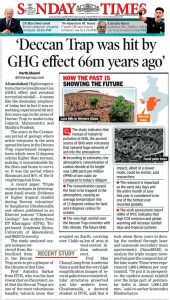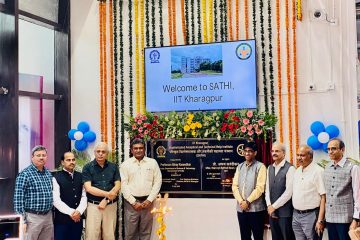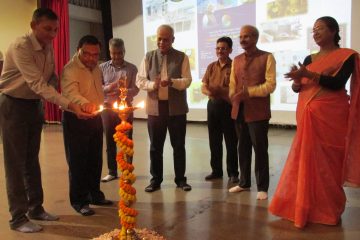
Deccan Trap lava hills in Western Ghats (Left) and columnar basaltic lavas (Right) which erupted 66 million years back killing dinosaurs and most life on earth.
A team of scientists from IIT Kharagpur and Academia Sinica, Taipei have indeed found evidence of triple oxygen isotopes of intertrappean fossil woods that led to very high annual rainfall during the catastrophic volcanism of Deccan trap that erupted in India about 66 million years back. The eruption drove a major mass extinction killing nearly 80% of all species of animals including the Dinosaurs. The depleted values of the oxygen isotopes suggest a higher tropical rainfall (1600 mm/y) in island India during terminal Cretaceous period. The increase in rainfall and its waning in the early Palaeocene closely follows change in palaeo-atmospheric pCO2 suggesting a possible underlying link. The inferred rainfall increase is consistent with modern climate models and palaeobotanical evidence.

Prof. Anindya Sarkar
Department of Geology and Geophysics
IIT Kharagpur
“The available records of the atmospheric CO2 concentration and temperature over both land and ocean during the time of Deccan Trap eruption were analyzed. This was a period of cataclysm. All around the central and western India, Deccan trap lavas were erupting spewing huge amount of CO2 from deep interior of the earth thus increasing the then atmospheric CO2 concentration to as high as 1000 ppm (parts per million). The land and ocean temperatures increased by ~13°C and ~4°C respectively. It was a hot earth and unbearable for life. The rainfall, both before and after this high CO2 concentrated earth was just as normal as today. This was an ancient analogue of what our future greenhouse earth could be,” said IIT Kharagpur’s Prof. Anindya Sarkar of Geology and Geophysics who led the research.
Fossil fuel emission has increased the CO2 from pre‐industrial level of 280 ppm to ~420 ppm in 2023. Climate models suggest that a doubling of CO2 will intensify the atmospheric circulation and consequently the rainfall. Many experts, however, believe that the climate change due to such fast rate of global warming is now irreversible and another mass extinction is just imminent, added Prof. Sarkar.

66 million year old fossil trees from the lake sediments within Deccan lava flows and microscopic photograph of vascular bundles in palm tree (left), and Scanning electron microscopic image of the cellular structures of fossil palm trees (right)
The 2023 AR6 report by the Intergovernmental Panel on Climate Change (IPCC) warns if the CO2 emission and global warming continues unabated, annual wettest day precipitation will increase by manifold across all continents. Monsoonal precipitation associated with tropical cyclones over India will also increase by 40%. While these predictions are made through climate models, they can only be tested by studying the rainfall record in the past when the earth went through natural warming phase due to high CO2 emission.

The laser ablation system developed at IIT Kharagpur capable of analyzing ultra‐low quantity of rare isotopes of oxygen in silicate phases (shown by arrow)
“Deccan Traps are one of the most voluminous basaltic volcanic lavas erupted on Earth covering over 500,000 sq. km of the west‐central Indian subcontinent. We retrieved the past rainfall by analyzing oxygen isotopes in fossilized trees those grew around the lakes formed over the basaltic lavas of Deccan traps. It was as if an ancient forest was fossilized. These lakes were formed during the quiescent period between two successive lava flows. Known as intertrappeans, the sediments in these lakes contain abundant plant, frog and fish fossils. The trees were exceptionally well preserved and buried immediately after they fell in lake beds making them robust climate recorder,” added Prof. Sarkar.

Prof. Mao Chang Liang
Academia Sinica
“We studied very high magnification images of several palm trees from these lake sediments and found that their internal cellular structures are preserved just like modern trees,” said collaborator Prof. Mao Chang Liang from Academia Sinica.
There is considerable debate about the effect of future global warming on tropical precipitation. Interpretations from the global climate models differ due to an inadequate understanding of the processes controlling rainfall and associated feedback. The robustness of the predictions is also limited due to the lack of deep time data of precipitation in a high CO2 and warmer globe that existed in the geological past.

Sangbaran Ghoshmaulik
Ph.D Student
IIT Kharagpur
“Getting information about the past rainfall is tricky. We used a very novel and new technique of Laser beam as well as NanoSIMS (Nanoscale Secondary Ion Mass Spectrometry) where the fossil trees were analyzed for all the three isotopes of oxygen namely, 16,17, and 18. The isotopes in the fossil trees record the isotopic composition of the lake water derived from rainfall. Analyzing isotopes of mass 17 is difficult since it occurs in extremely small quantity in natural materials. Globally there are only three or four laboratories those can reliably do this job. It took nearly four years for us to develop this method but once done the results were very startling” said Sangbaran Ghoshmaulik, a Ph.D student at IIT Kharagpur and the lead author of the paper.
The Cretaceous period represents an example of hot deep sea and land temperatures often exceeding 10 °C and 30 °C respectively and high CO2 earth. The intertrappean sediments deposited during the voluminous basaltic outpouring of end-Cretaceous Deccan volcanism in India provide a unique repository to infer the magnitude of tropical precipitation during an enhanced greenhouse period.

Prof. Sourendra Bhattacharya
Co‐author of the Paper
IIT Kharagpur
“Excepting the arid/semi‐arid regions, the modern annual rainfall over large part of peninsular India on an average is about 1000‐1200 mm. Our data suggested that these fossil trees recorded 1800‐1900 mm/year rainfall. This is exactly what the IPCC predicts in case of a future extreme 4oC warming of the planet,” said Prof. Sourendra Bhattacharya, a co‐author of the paper. The study has just been published online in prestigious Elsevier Journal Chemical Geology.
Link of the paper:
https://www.sciencedirect.com/science/article/abs/pii/S0009254123002991
Media Coverage :
| Times of India | The Hindu |
| Ananda Bazar Patrika | UNI |
| Outlook India | Dainik Jagran |

Sunday Times

Dainik Jagran
Contact person : Prof. Anindya Sarkar, Department of Geology and Geophysics, IIT Kharagpur
Email: sarkaranindya@hotmail.com
Edited By : Poulami Mondal, Digital & Creative Media Executive (Creative Writer)
Email: poulami.mondal@iitkgp.ac.in, media@iitkgp.ac.in, Ph. No.: +91-3222-282007
Follow us on: Facebook – IIT Kharagpur; Twitter – @IITKgp; Instagram – @iit.kgp; LinkedIn – Indian Institute of Technology
For news visit: https://kgpchronicle.iitkgp.ac.in/



